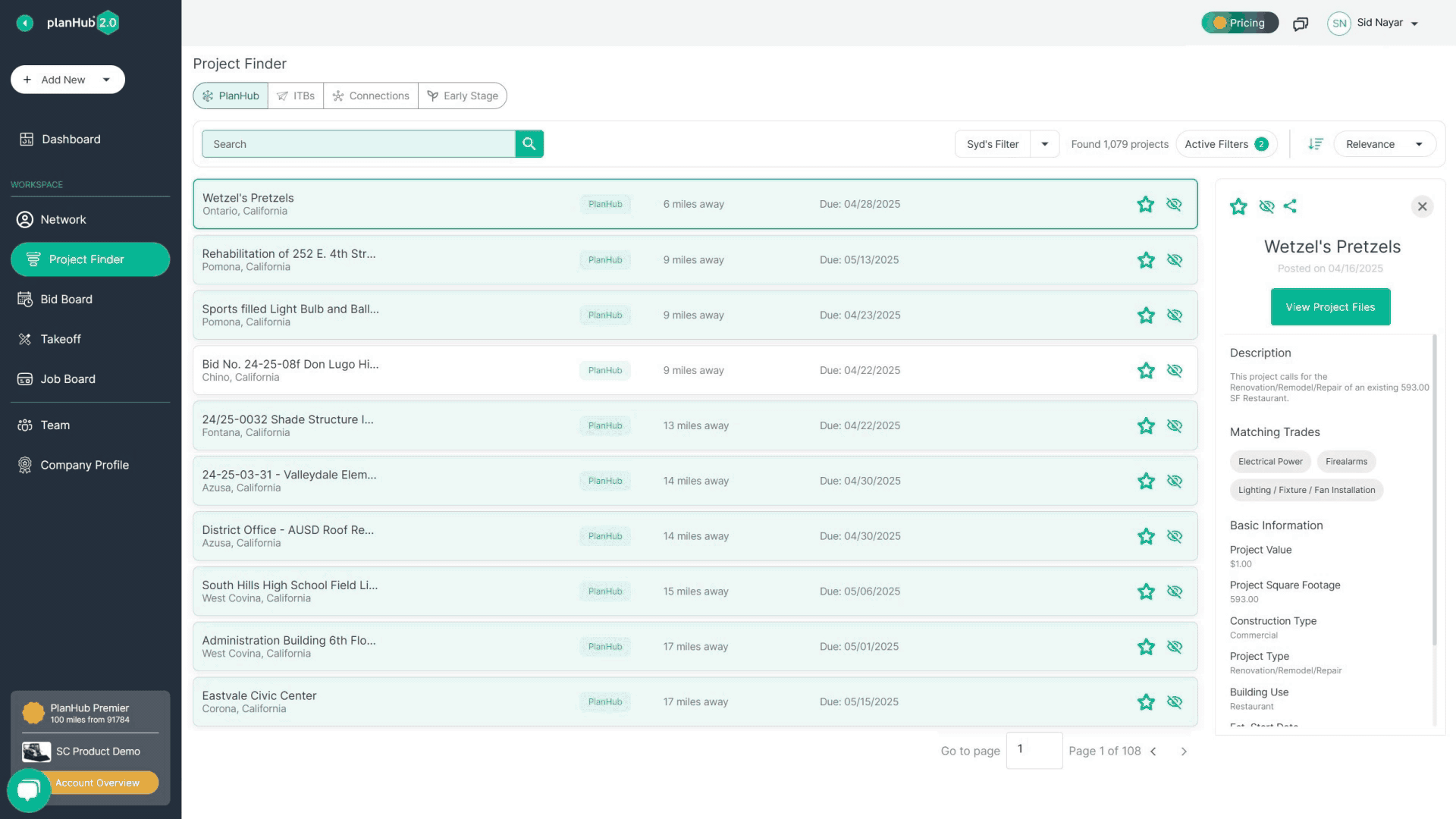Subcontractors

From Projects to Execution - It’s All Here.
PlanHub 2.0 helps contractors win more projects and grow their business faster by bringing every aspect of preconstruction together in an all-in-one tool.
Trusted by Thousands of Construction Professionals Nationwide
Why Subcontractors Choose PlanHub
Connect
Network with 55,000+ general contractors and 4,500+ suppliers, streamline communication and unlock opportunities for more profitable projects.
Grow
Find the right projects and expand your business with tools that help you bid smarter and win more work.
Simplify
PlanHub’s easy-to-use, all-in-one platform reduces hassle, keeps you organized, and helps you stay on track to boost profitability so you can compete.
It's saving me time every day, every time I log on. My productivity is that much faster because everything I need is right here in front of me. I've been able to almost double my business using PlanHub.
Doug Conforti
Lead Estimator, Southern Environmental Services, Inc.


Subcontractor Tools
Connect
Build Strong Connections That Drive Your Business Forward
Build strong connections that drive your business forward. Highlight your expertise to a network of 55,000+ general contractors ready to work with you. Strengthen relationships, streamline communication, and unlock opportunities that help you secure more profitable projects.
General Contractor Directory
Connect with trusted general contractors in your area.
- Extensive Network: Access a growing community of 50,000+ General Contractors.
- Direct Connections: Communicate directly using detailed contact information and actionable insights.
Prequalification
Showcase Your Qualifications to Stand Out and Win More Projects
- Highlight Your Credentials: Build a comprehensive profile to demonstrate your reliability and expertise.
- Boost Visibility: Stand out to general contractors with PlanHub’s proprietary prequalification tools to highlight your credentials and track record.
Relationship Management
Strengthen Relationships, Win More Work
- Digital Rolodex: Save and organize your contacts in one place – directly from PlanHub’s extensive network or simply add your own.
- Centralized communication: Easily track all projects, bids, and interactions per general contractor—no more digging through emails.
- Built-in productivity: Ensure high-quality, timely interactions by setting reminders, assigning tasks, storing documents and more.
Grow
Win More Projects That Fit Your Business
Gain access to over 3,000+ new commercial projects out for bid each month. With advanced filters, document-level search, real-time notifications, mobile tools and more, you can target the right jobs, bid smarter, and grow your revenue with confidence.
Commercial Project Finder
Discover and bid on new, relevant commercial opportunities out for bid tailored to your trades and location.
- Robust Filtering & Keyword Matching: PlanHub’s extensive project database connects you to commercial opportunities that fit your skills and specialties. View projects by the trades, locations, and keywords that matter to you.
- Unlimited Opportunities: Bid on as many jobs as you want, with unlimited Invitations to Bid (ITBs).
- Key Details At A Glance: Access critical project details easily, including keyword-matched documents and robust filters.
- Expand Your Network: Build relationships with general contractors seeking your services.

Early Project Access
Discover planning-phase opportunities before bids open and before most subcontractors even know they exist.
Get access to 196k Early Stage Projects, with thousands more added each month.
Affordable Access: Starts at around $17/month (billed annually).
Get Ahead: Access verified stakeholder contact details & build relationships early.
Integrated Workflow: Manage these opportunities directly on your Bid Board.
ITBs & Automatic Matching
Automatically receive Invitations to Bid tailored to your capabilities and location, and respond effortlessly from desktop or on the go with PlanHub’s mobile app.
- Project Matching: PlanHub uses your profile to generate a list of relevant projects for you to review.
- Efficient Responses: Review, save, and respond to ITBs quickly, whether you’re using a desktop or mobile device.
- Personalized Keyword Notifications: Set custom keywords and get notified whenever they appear in a project’s documentation or plans.
- Seamless Mobile Integration: Your ITB mobile app syncs fully with your Bid Board, ensuring that jobs, tasks, messages, and updates are always accurate and real-time across all platforms for you and your team.
Market Intelligence
Know the Market, Make Smarter Decisions
- Competitive Analytics: See how many views, plan downloads, and bids a project has.
- Optimize Bidding Strategy: Optimize your bid strategy now that you can gauge competition at a glance.
Bid Builder
Create detailed and professional bids effortlessly to maximize your chances of winning work.
- Work Smarter: Create professional, easy-to-read bids at lightning speed in a single platform, without ever starting from scratch or leaving PlanHub.
- Powerful Keyword Search: Easily search for keywords in project file and documents and see exactly where they appear.
- Supplier Integration: Request material estimates directly within PlanHub for a one-stop-shop bidding experience.
Simplify
Save Time & Focus
on What Matters
Spend less time managing and more time growing your business. PlanHub’s easy-to-use, all-in-one platform reduces hassle, keeps you organized, and helps you stay on track to boost profitability so you can compete.
Bid Board
Track all your potential and active bids in one place, ensuring you never miss a deadline or opportunity.
- Centralized Bids: Import and organize all your bids in a streamlined dashboard, with stages clearly defined for easy tracking.
- Simplified Management: Assign responsibilities, set due dates, receive automatic reminders and more to stay ahead of deadlines.
- Seamless Integration: Transition smoothly from each bid into takeoffs or other tools, and push the jobs you win directly into the Job Board.
Job Board
Stay on top of won projects from start to finish, tracking tasks, timelines, and outcomes effortlessly.
- Simple, Efficient Management: Seamlessly move projects you’ve won over from Bid Board. Keep projects on schedule and under budget with task tracking and milestones.
- Team Management: Assign tasks, track progress, share images and videos, store project documents and more, all from one shared space.
- Field Mobile Application: Your integrated mobile application for field teams allows you to assign tasks, receive images and videos, chat, and track progress with your field teams.
Field Mobile Application
Your integrated mobile application for field teams allows you to assign tasks, receive images and videos, chat, and track progress with your field teams.
- Integrated Task Management: Integrates with your Job Board so you can assign tasks, track progress, and ensure field workers have access to their daily schedules and critical project documents.
- Enhanced Collaboration: Share and access project media, including photos, videos, and files, directly through the app, while staying connected with integrated chat and call features.
- Simplified Time Tracking: Field workers can log hours effortlessly, with data automatically syncing to the project in your Job Board.
Takeoff & Estimation
Save time, boost precision, and modernize your process with tools that help you win more bids and deliver exceptional results.
- Simple Yet Powerful: Handle takeoffs, estimates, and bid preparation all in one place. Import contractor files, collaborate with your team in real-time, and never miss a deadline.
- Robust Customization: Create accurate estimates using pre-built templates or personalize your process to reflect your labor costs, materials, and project specifics.
- Comprehensive Resources: Access a 92,000-item cost library, or build your own list of repeatable assemblies for quick, accurate quoting on kitchens, bathrooms, and other specialty projects.
Trusted By
Hundreds of thousands of contractors
and Suppliers Nationwide
Win More Jobs,
Manage Less Hassle
Join the thousands of subcontractors who trust PlanHub to help them simplify bidding, connect with the right projects, and grow their businesses.

